
The Future of LTL Freight: Trends and Innovations in Less Than Truckload Shipping
Less-Than-Truckload (LTL) freight shipping has undergone significant transformation in recent years. As businesses strive for cost efficiency, speed, and sustainability, the LTL industry is embracing new technologies and strategies to meet evolving supply chain demands. In this blog, we’ll explore the key trends and innovations shaping the future of LTL freight shipping.
1. Technology-Driven Advancements in LTL Shipping
AI & Machine Learning in Freight Optimization
Artificial Intelligence (AI) and Machine Learning (ML) are revolutionizing logistics by enabling smarter route optimization, demand forecasting, and real-time pricing models. Carriers use AI to predict shipping patterns, reduce empty miles, and optimize load distribution, ensuring cost savings and improved efficiency.
Real-Time Tracking & Visibility
Shippers now demand end-to-end shipment visibility, and LTL carriers are responding by implementing advanced GPS tracking, Internet of Things (IoT) sensors, and blockchain technology. These innovations provide real-time updates, reduce shipment losses, and improve transparency for businesses relying on LTL freight.
Automation & Robotics in Warehousing
Automated warehouses and robotic sorting systems are becoming standard in LTL freight hubs. These technologies reduce labor costs, minimize errors, and accelerate shipment processing, leading to faster deliveries and enhanced supply chain efficiency.
2. Sustainability & Green Logistics in LTL Freight
Eco-Friendly Fleets & Alternative Fuels
The push for sustainable logistics is driving LTL carriers to adopt electric trucks, hydrogen-powered vehicles, and biodiesel solutions. Companies are investing in greener fleets to comply with environmental regulations and reduce carbon footprints.
Carbon Footprint Reduction Through Load Optimization
LTL shipping is inherently more eco-friendly than full truckload (FTL) due to shared trailer space. Carriers are now using AI-driven load consolidation techniques to further optimize freight loads, cutting down on fuel consumption and emissions.
Sustainable Packaging & Recycling Initiatives
Many LTL shippers are shifting towards recyclable materials, minimal packaging waste, and reusable shipping containers. This trend aligns with the growing corporate commitment to sustainability in the supply chain.
3. The Role of E-Commerce in LTL Freight Growth
Last-Mile Delivery Innovations
With the surge in e-commerce, businesses require faster and more efficient urban freight distribution. LTL carriers are integrating last-mile delivery solutions with urban micro-fulfillment centers to meet consumer demands for speed and accuracy.
Freight Consolidation & Micro-Fulfillment Centers
Retailers and e-commerce giants are increasingly using freight consolidation strategies to optimize LTL shipments. Micro-fulfillment centers are enabling quicker regional deliveries by storing products closer to customers.
Dynamic Pricing & On-Demand Freight Services
Technology-driven dynamic pricing models are allowing LTL carriers to adjust freight rates based on real-time demand, capacity, and seasonal fluctuations. On-demand freight services are also gaining popularity, offering greater flexibility for businesses.
4. The Evolution of 3PL & Digital Freight Marketplaces
AI-Powered Freight Matching
Third-Party Logistics (3PL) providers and digital freight platforms are leveraging AI to connect shippers with available carriers instantly. This reduces wait times, optimizes truck capacity, and streamlines operations for both parties.
Self-Service Freight Booking
The rise of digital freight marketplaces has enabled businesses to instantly compare rates, book LTL shipments, and track deliveries in real time. This self-service approach simplifies logistics management and enhances efficiency.
Blockchain for Secure Transactions
Blockchain technology is being integrated into freight transactions to enhance data security, automate smart contracts, and eliminate billing disputes. This innovation ensures greater accuracy and trust in the shipping process.
5. Challenges & Opportunities in the Future of LTL Shipping
Capacity & Infrastructure Limitations
While LTL demand continues to rise, challenges like limited warehouse space and congested transportation networks must be addressed. Investments in smart infrastructure and AI-driven logistics planning will help mitigate these constraints.
Labor Shortages & Workforce Automation
The trucking industry faces an ongoing driver shortage, pushing companies to explore automation in freight handling and autonomous trucking technologies. AI-powered fleet management is also optimizing driver schedules to improve retention.
Regulatory Changes & Compliance
As sustainability regulations tighten, LTL carriers must adapt to new emissions standards, safety regulations, and cross-border compliance rules. Staying ahead of these changes will be crucial for long-term success.
Conclusion
The future of LTL freight is being shaped by technology, sustainability, and evolving consumer demands. Companies that embrace AI-driven logistics, green transportation, and digital freight solutions will gain a competitive edge in the industry.
At Gravity Concepts, we stay ahead of these trends to provide efficient, cost-effective, and future-ready LTL freight solutions. Contact us today to streamline your shipping operations!



